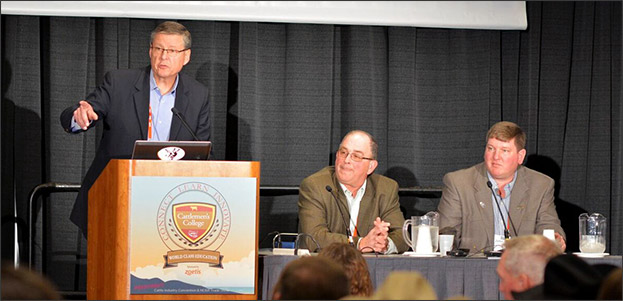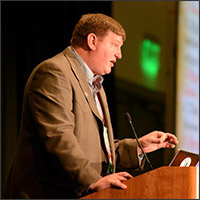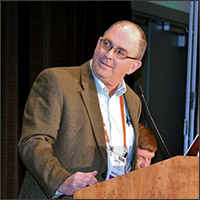
From left, Moderator Tom Field, University of Nebraska, led panelists Jerry Wulf and John Schroeder in sharing what they have learned about adding value to feeder cattle.
Adding Value, Opportunity
Two cattlemen share similarities as they take different paths to profit.
SAN DIEGO, Calif. (Jan. 27, 2016) — Adding value to cattle doesn’t have to mean added paperwork and special programs.
Sometimes it’s as simple as producing exactly what the market says it wants. Darr Feedlot, near Cozad, Neb., aims for a specific target: a safe, humanely handled, upper-two-thirds Choice, Yield Grade (YG) 2 carcass.
 Every day, you get an opportunity to put a marbling point in,” John Schroeder of Darr Feedlots said.
Every day, you get an opportunity to put a marbling point in,” John Schroeder of Darr Feedlots said.
“We have standard operating procedures for perfect mixing and delivery. Every biteful needs to be the same,” Schroeder said, noting they complement that with “perfect delivery.” That’s backed by monthly feed samples and regular feed-truck monitoring and maintenance, and even checks and balances with employees.
They want to maximize genetics and get into the premium-Choice category, and that means making the most of every day.
“Marbling is a linear line. Every day, you get an opportunity to put a marbling point in,” Schroeder said. He doesn’t know of a way to make up for missed opportunities to lay down that intramuscular fat.
That takes teamwork between feeder and ranch supplier, he said. Preconditioning done right — without cutting corners on duration or method — is important.
“Immunity. We want to build it at the ranch and at the yard with timely vaccination, backed up with mineral and nutrition,” Schroeder said.
They “spike” vitamins at certain points in the feeding period and tailor mineral programs based on the class of cattle.
That all goes back to some of Schroeder’s key management philosophies: “Try to manage individuals and try to understand why they advance differently,” and “match genetics and timely management to achieve your goals.”
Starting at the end
Fellow presenter Jerry Wulf of Wulf Cattle near Morris, Minn., explained his family’s “value-added” roots run deep. Their Limousin and Angus seedstock business got its start as a way to complement their feeding enterprise.
 “We wouldn’t want to attempt to raise those value-added cattle without knowing we had a market for them,” Jerry Wulf told Cattlemen’s College attendees.
“We wouldn’t want to attempt to raise those value-added cattle without knowing we had a market for them,” Jerry Wulf told Cattlemen’s College attendees.
They needed an influx of consistent genetics. Yet, he looks to the end of the cycle before turning to the beginning.
“We wouldn’t want to attempt to raise those value-added cattle without knowing we had a market for them,” Wulf said. They currently produce for the non-hormone-treated cattle (NHTC) and natural markets.
Still, those cattle bound for niche programs share the same difference-makers as conventional ones: “health, feed conversion and carcass.”
The Wulfs focus on cattle comfort.
“Happy cows are working for us and make our job a lot easier,” he said.
Echoing Schroeder’s comments about communication through the chain, he said if they can’t get individual carcass data back, they switch processors.
“Feeding only known genetics and having the relationship with cattlemen, and now dairymen, we feel we’re well-suited to go after what’s out there for value-added programs,” he said.
No matter what premiums a cattleman is going after, Schroeder added, this advice rings true: “You have to begin with the end in mind, and you have to have a plan.”
Editor’s Note: Miranda Reiman is industry information assistant director for Certified Angus Beef LLC. The articles used within this site represent a mixture of copyrights.This article was written by or under contract of the Angus Journal, an Angus Media publication. If you would like to reprint or repost the article, you must first request permission by contacting the editor at 816-383-5270; 3201 Frederick Ave., Saint Joseph, MO 64506. The Angus Journal claims copyright to this website as presented. We welcome educational venues and cattlemen to link to this site as a service to their audience.

